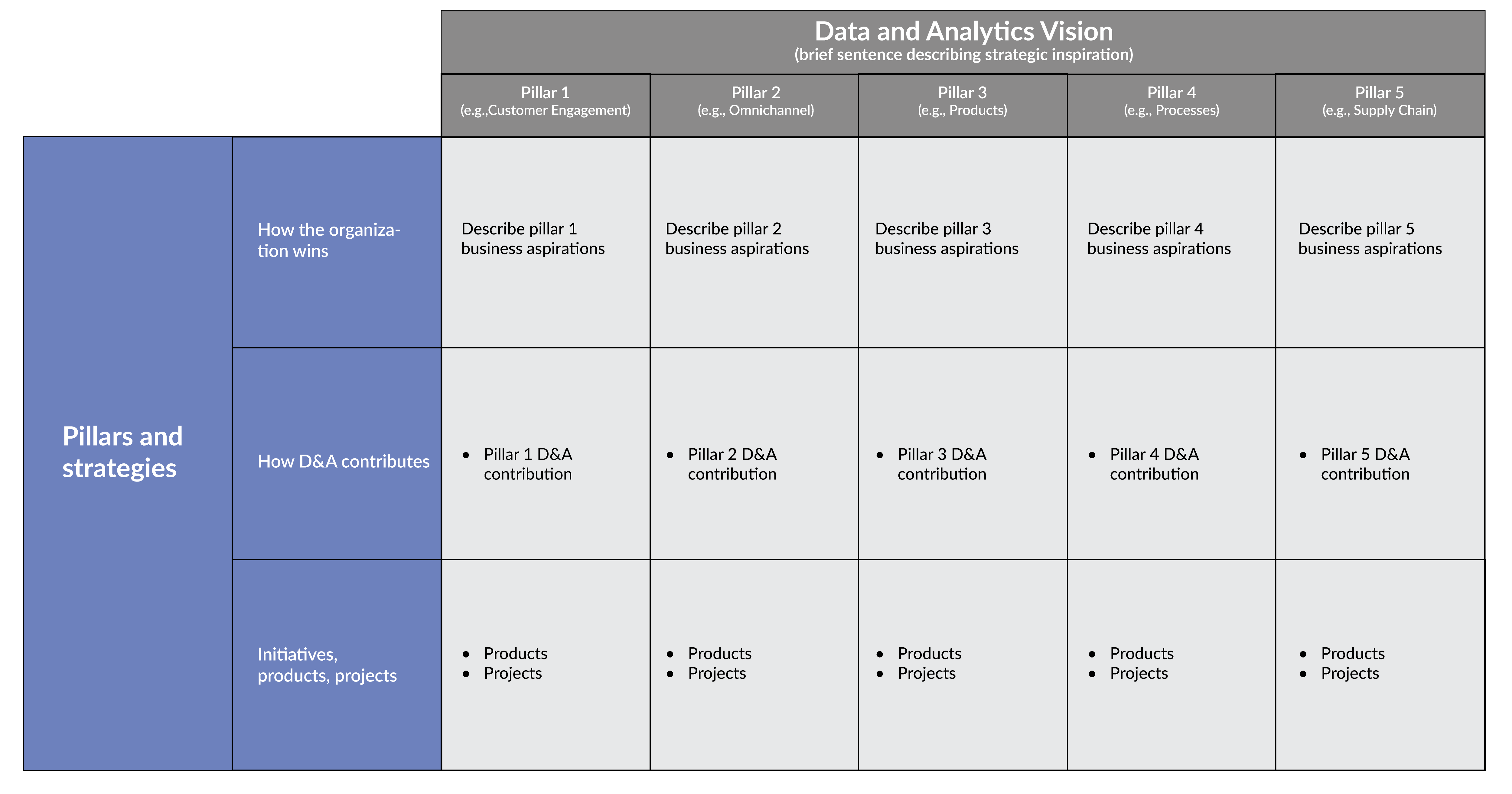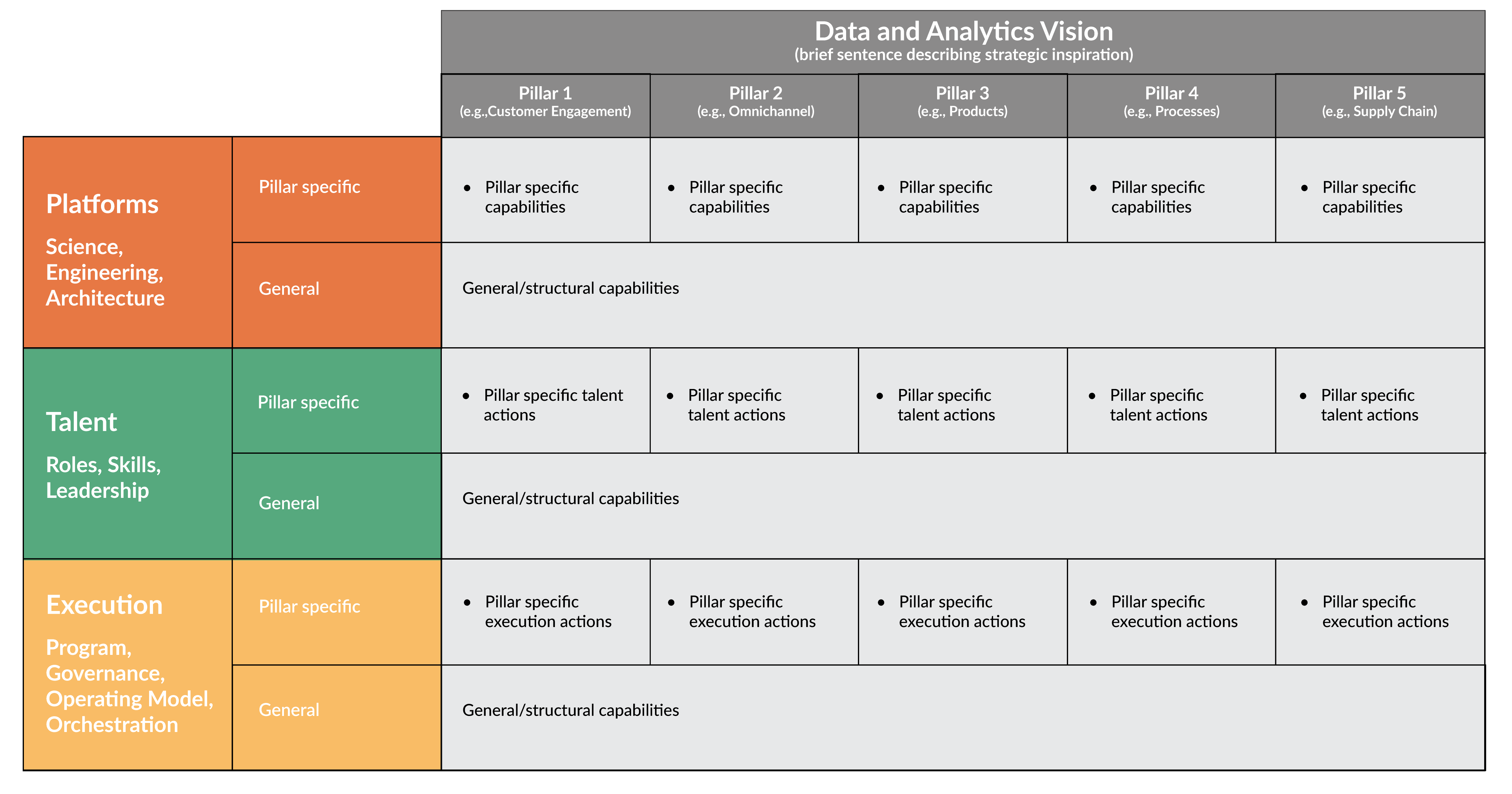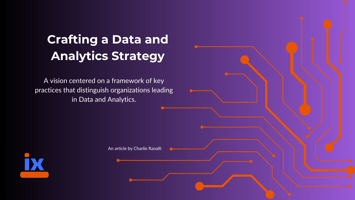Back in December, we introduced the ixpantia framework, shedding light on the key practices that...
Crafting a Data and Analytics Strategy
Back in December, we introduced the ixpantia framework, shedding light on the key practices that set apart organizations thriving in Data and Analytics (D&A). At the forefront of this framework lies the imperative first step – crafting a robust D&A strategy.
Let's double click into the details of this strategy, often resembling a matrix, with pillars as its columns and strategic actions as its rows.
Aligning Pillars with Business Strategy
The foundation of the D&A strategy matrix lies in the pillars, which serve as the guiding principles aligning D&A with the business model, priorities, and overarching strategy. Two distinct approaches exist for identifying these pillars: aligning with key elements of the business model or utilizing domains – clusters of processes and activities in the operating model.
For instance, in the Consumer-Packaged Goods (CPG) industry, pillars could encompass consumers, channels, customers, products, suppliers, employees, and processes. Alternatively, domains could include demand shaping, commercial execution, logistics, production, supply chain, and talent management.
Organizations in the early stages (the "describe" and "diagnostic" stages, as per the Gartner Maturity Model) may benefit more from aligning with key business model elements. In contrast, those in the "predictive" and "prescriptive" stages find greater impact in aligning with domains. The strategic decision is influenced by the organization's journey, with a focus on rapid learning for beginners and driving impactful change for advanced programs.

Opportunities: Illuminating the Strategic Landscape
The top row of the matrix is dedicated to exploring opportunities within each pillar. It articulates how D&A will contribute to long-term strategic aspirations, operational advantages, and innovation. This includes specific Objectives and Key Results (OKRs) that serve as a compass for measurable success.
Whether enhancing customer experiences or optimizing supply chain efficiency, each pillar's potential must be meticulously outlined, and it is very effective to start by answering two questions: how does the organization win?, and: how can D&A contribute to that success?
This is the creative thinking phase, and requires tactfully combining and balancing ambitious long term aspirations with realistic short term goals. Both must be documented and discussed, to then apply sensible decision making to chart a path to organically grow both capabilities and impact.
Initiatives and Projects: Breathing Life into Strategy
Subsequent “rows” delve into initiatives and projects that give life to pillar-specific strategies. These endeavors, varying based on business domains and the maturity of the D&A program, must be specific, measurable, and actionable. These initiatives take the form of projects or products and are crucial for translating strategic goals into tangible outcomes
Enabling Capabilities
Rows follow, describing the enabling capabilities essential for implementing the initiatives, projects, or products. These capabilities fall into categories such as science, engineering, architecture, talent, and execution. Some are general, supporting all pillars (e.g., underlying data architecture), while others are specific to individual pillars (e.g., governance of a dataset for a particular product). Balancing these capabilities is paramount for holistic and sustainable progress.
The Data
A comprehensive Data and Analytics strategy necessitates a dedicated Data section. This segment details the current state of data domains, evaluating existence, access, quality, governance, and management. It then outlines actions and investments required to bridge gaps, ensuring a robust foundation for effective analytics.
Program, Operating Model and Governance
The program structure and operating model, often adopted as a federated model with centralized functions orchestrating distributed initiatives, are pivotal in driving a D&A strategy forward and must be an integral part of it.
They provide a structured execution framework, ensuring strong and focused leadership, efficient coordination, governance, and collaboration between teams and across organizational units. A well-designed operating model fosters agility, dynamically aligning data initiatives with business goals, optimizing resource allocation, and facilitating seamless integration of analytics into organizational processes, enhancing overall strategic execution.
Organizations that have a Digital Transformation initiative in place will likely align the D&A program and its operating model with the overall design of the transformation plan, leveraging foundational capabilities like strategic planning, a PMO office, Agile/Scrum methodologies, and change management, while keeping leadership and management separate to guarantee focus and initiative. Smaller organizations will start with a core D&A team fostering a community of "data experts" located in the teams developing the first projects or products.
Navigating the Roadmap
To bring the matrix to life, elements must be organized into a roadmap that reflects the starting point, investment possibilities, and a realistic speed of change. The recommended approach involves early work on reference frameworks (architecture, governance, operating model) and phased implementation. This ensures synchronization of initiatives with related enabling capabilities, creating a roadmap that is not just aspirational but also practical.
Balance and Synergy: The ixpantia Framework
All parts of the D&A strategy matrix are crucial and must be balanced in terms of aspiration, detail, and investment. The ixpantia framework, represented as a flywheel, encapsulates the synergy between strategy, talent, platforms, and execution. Each phase is interconnected, moving at the speed of the slowest component. This iterative approach emphasizes the holistic nature of the D&A journey.

In conclusion, the matrix structure provides a comprehensive roadmap for organizations aiming to excel in D&A. By aligning with business essentials, defining opportunities, implementing strategic actions, and prescribing investments in enabling capabilities, organizations can unlock the full potential of their data, driving innovation, operational efficiency, and strategic success.




.png?height=200&name=blog%20banner%20(2).png)